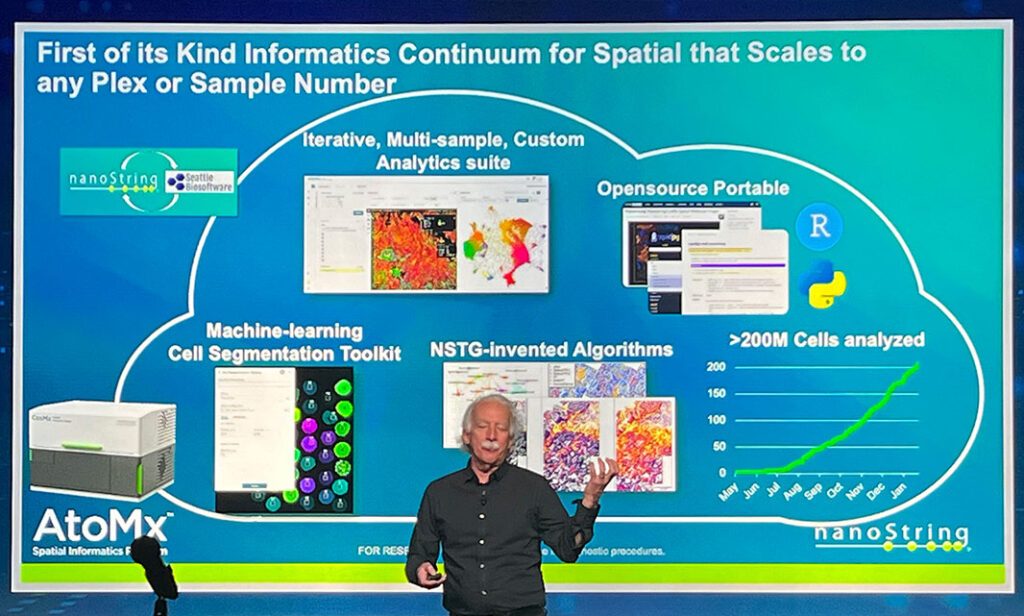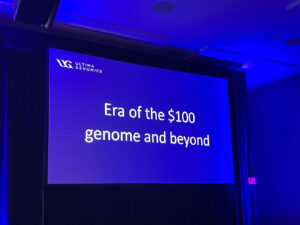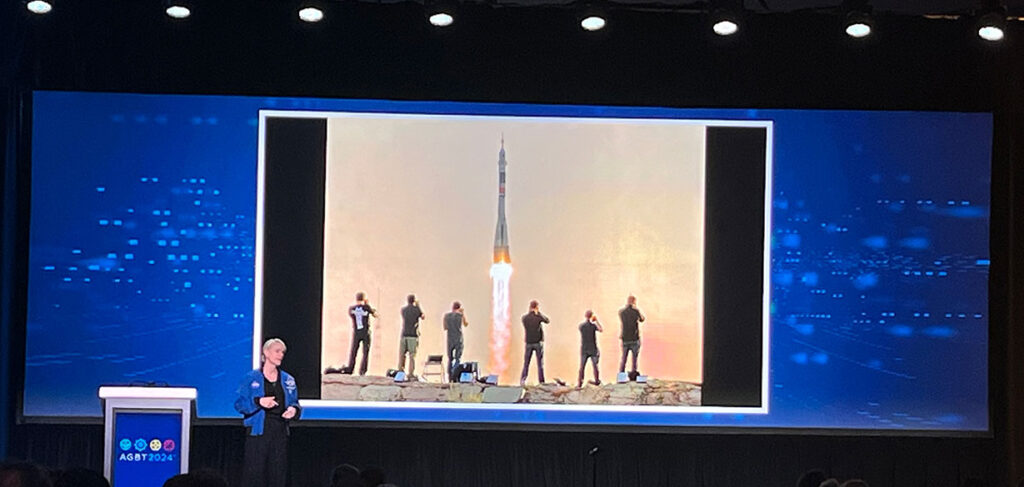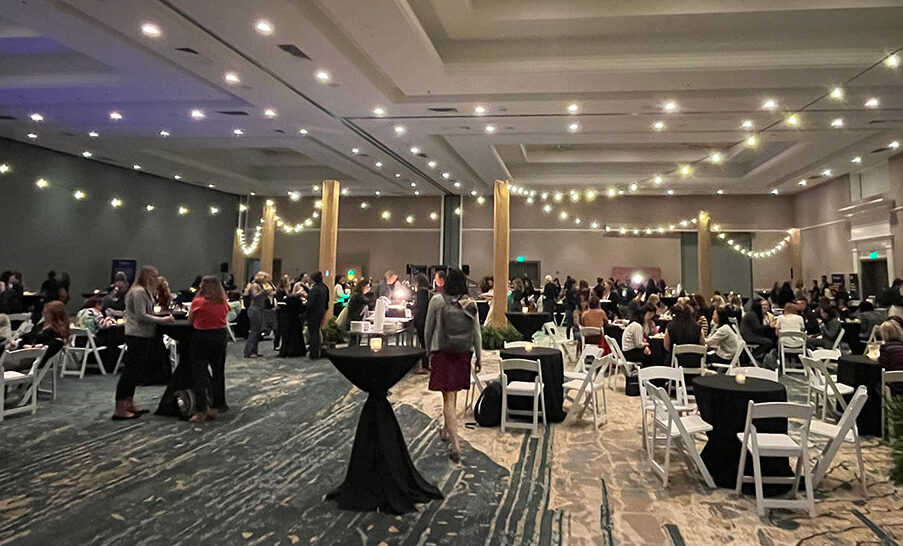Genomics aficionados flock to Florida to attend the annual AGBT (Advances in Genome Biology and Technology) conference to stay abreast of the new technologies being developed in the field, to learn about new research going on in academic laboratories, and to make new contacts (and see old friends!). Attendees are more than collaborators and competitors; they make up an international community driving progress in one of the most exciting fields in science: the exploration of the genome.
AGBT 2024 took place in Orlando, FL, in early February. A full debrief from AGBT is critical to understanding where the world of next-generation sequencing (NGS), genomics, and spatial biology is heading. Here, GEN summarizes the highlights that garnered our attention during the meeting.
Spatial drama
The biggest news at AGBT actually broke the night before the opening session—when NanoString Technologies announced that it had filed for Chapter 11 bankruptcy protection. The company blamed the $31-million jury award assessed against it last November, in a patent infringement case filed by rival 10x Genomics.
Despite the news, NanoString was an upbeat and vibrant presence at AGBT. And the company’s spatial technology platforms, including the CosMX and the GeoMX, were on display in multiple talks and posters. Joe Beechem, PhD, NanoString’s CSO, told GEN in no uncertain terms that the company is not going anywhere. “We believe in our technology. We invented this technology. We are going to continue to defend it,” he told me.

Vizgen, Bruker, Lunaphore Technologies, and Advanced Cell Diagnostics (ACD).
Lunaphore and ACD, Bio-Techne brands, presented a spatial multiomics workflow on the COMET platform. They asserted that this technology provides the first fully automated, same-section, multiomics workflow for the simultaneous detection of RNA and protein targets. The platform combines ACD’s RNAscope HiPlex Pro and sequential immunofluorescence (seqIF) with standard, nonconjugated primary antibodies.
A presentation by 10x Genomics highlighted multiple technological advances by the company, including Visium HD—a higher resolution, single-cell, whole-transcriptome version of the company’s spatial workhorse, Visium. Also unveiled was the next generation of 10x Genomics’ single-cell technology architecture, GEM-X. It will enable the company’s Chromium platform to run new assays. The first two products of the new GEM-X technology architecture are Chromium GEM-X Single Cell Gene
Expression v4 and GEM-X Single Cell Immune Profiling v3 assays—for both, 10x Genomics is accepting preorders.
Vizgen (another company facing lawsuits from 10x Genomics), announced a partnership with Scale Biosciences (a San Diego–based single-cell company) to bring single cell and spatial together. Vizgen also announced that its customers will soon be able to design custom MERFISH (multiplexed error-robust fluorescence in situ hybridization) panels for characterizing the expression of nearly 1,000 genes.
This new capability represents a doubling of the multiplexing capacity of Vizgen’s MERSCOPE platform. Terry Lo, Vizgen’s CEO, told GEN that the company plans to develop and release an enhanced MERFISH chemistry to increase sensitivity in formalin-fixed, paraffin-embedded samples, where RNA can frequently be degraded.
Somewhere in the landscape shaped by single-cell biology, proteomics, and spatial lies the Swedish company Pixelgen Technologies. Simon Fredriksson, PhD, Pixelgen’s co-founder and CEO, told GEN that the company is fine with being called a spatial company—so long as “spatial” refers the spatial organization of proteins on a single cell, not the cellular organization of the tissue.
The company’s product, a kit that was launched last summer, allows users to localize 80 proteins. This is particularly important in the immune system, where a protein’s location on a cell is key to its function.
Library prep makes waves
There was a surprising amount of buzz surrounding a new PCR machine. That’s right, a PCR machine. A new company, N6 Tec, created a PCR machine for NGS library prep in which each well can be controlled individually.
The Pleasanton, CA, startup was co-founded by Yassine Kabouzi, PhD, and Pranav Patel, PhD. Kabouzi has extensive experience in the development of semiconductor instrumentation, and Patel has participated in the development of technologies at PacBio and 10x Genomics. Most recently, Patel founded 2D Genomics (which was acquired by Bio-Rad Laboratories).
Kabouzi and Patel sought to solve a longstanding problem in the NGS space. Despite the explosion in NGS, the bottleneck between library prep and multiplexed sequencing has remained unchanged. N6 Tec notes that 80% of sequencing time and expenses are not linked directly to sequencing but rather to preparation and quantization.
New England Biolabs (NEB), located in Ipswich, MA, is celebrating its 50th anniversary this year. The company is also marking 15 years of development on its NEBNext line of NGS library preparation reagents. At the meeting, NEB highlighted its new kits, which allow for further exploration of the epigenome with the launch of its 5hmC sequencing kit for base-specific detection of 5hmC sites. This is the first enzymatic method for 5hmC detection at single-base resolution.
Another New England company, the Beverly, MA-based SeqWell, sells a transposon-based system to allow for multiplexing. SeqWell announced a newly engineered transposase, TnX, which has less insertion site bias than its predecessor, Tn5, and can lead to increased library complexity. The company also announced a long-read format of the short-read kits.
Twist Bioscience, based in South San Francisco, CA, also announced a prep kit—the Twist Flex Prep Ultra High-Throughput Kit. It is designed to increase throughput and accelerate NGS microarray conversion and expand the adoption of NGS in agricultural genomics.
“In agricultural genomics, researchers often test thousands of samples at once, relying heavily on automation to support large-scale testing,” said Emily Leproust, PhD, co-founder and CEO of Twist Bioscience. “Many researchers continue to perform traditional microarray-based workflows, as the overall higher cost per sample for NGS-based workflows has hindered adoption.”
NGS shifts into multiomics
Ultima Genomics, this year’s Gold sponsor, knows how to make a splash. In 2022, another year in which the company was a Gold sponsor, the company took the opportunity to “destealth” itself. Back then, Ultima was met with some skepticism. But at AGBT 2024, the company officially launched its high-throughput instrument, the UG 100. During the company’s lunchtime talk, Gilad Almogy, PhD, Ultima’s CEO, presented details of the instrument. They were: 99.4% indel F1 accuracy, Q60 single nucleotide variant accuracy, a run time of 12–14 hours, a throughput of 20,000 genomes per year, and a cost of $1.00/Gb.

Ultima also introduced ppmSeq (Paired Plus Minus Sequencing), which allows the company to achieve one-in-a-million single nucleotide variant accuracy. Dan Landau, MD, PhD, core faculty member at the New York Genome Center, illustrated how ppmSeq enabled one-in-a-million sensitivity from cell-free DNA, and how it could open the door to better minimal residual disease detection.
Singular Genomics and Element Biosciences both moved squarely into multiomics. For Singular, it was the announcement of a new instrument called the G4X. The company asserts that the G4X will combine sequencing and spatial readouts. More specifically, the G4X will offer fluorescent H&E staining, proteomics capabilities (high-resolution imaging of dozens of proteins), in situ detection of gene transcripts, and direct readouts of mutations within the same sample of tissue. The upgrade, for current users of the G4 sequencer, should be made available by the end of 2024.
Element has always had its sights beyond DNA. Speaking at the company’s sponsored lunch talk (and wearing a T-shirt that read, “Shift Happens”), CEO Molly He, PhD, presented the AVITI24. This is the first instrument that can analyze multiple biological signals (DNA, RNA, proteins, phosphorylated proteins, and cell morphology) simultaneously.
A multiomics slant was also taken by Complete Genomics, a U.S.-based subsidiary of MGI. The co-founder and CSO of Complete Genomics, Rade Dramanac, PhD, presented the company’s fleet of instruments before handing the microphone over to Christopher E. Mason, PhD, professor of physiology and biophysics at Weill Cornell Medicine, who presented research findings that had been obtained with STOmics, which is the company’s Stereo-Seq (Spatial Enhanced resolution omics-Sequencing) technology. While describing the analysis of omics studies designed to inform key genomic changes when humans are in space, Mason emphasized STOmics’ high resolution.

From every place on Earth
At AGBT 2024, as at all AGBT meetings, the new technologies were the major focus of attention. But the stage presentations were no less spectacular. For example, Mark Blaxter, PhD, head of the Tree of Life Programme and senior group leader at the Wellcome Sanger Institute, presented on the Earth Biogenome Project, which intends to sequence every organism on Earth. (The project has already completed 1,395 genomes and has 3,500 more in progress.)
In another notable presentation, Bridgett vonHoldt, PhD, associate professor of ecology and evolutionary biology at Princeton University, discussed “ghost wolves.” Essentially, she presented research that could support efforts to resurrect red wolf ghost alleles into North America’s wolf population. (The project started when a photo of a unique looking wolf was sent to her and piqued her interest.) And there was a fascinating talk on the first study on polar bears in Southeast Greenland by Kristin Laidre, PhD, senior principal scientist at the Polar Science Center, Applied Physics Laboratory, University of Washington.
The scientific developments that were discussed on the main stage perfectly complemented the technological advances that were celebrated in the company suites. Indeed, AGBT is an occasion to see how scientific developments and technological advances work together in a virtuous cycle. It is an event where, for one week, 1,000 scientists can catch a glimpse of a genomics playground—and join the fun themselves.One of the most highly anticipated announcements was the last one. Next year, the meeting will move back to Marco Island, FL—the meeting’s ancestral home—as AGBT celebrates its 25th anniversary. The genomics community is already looking forward to it.



